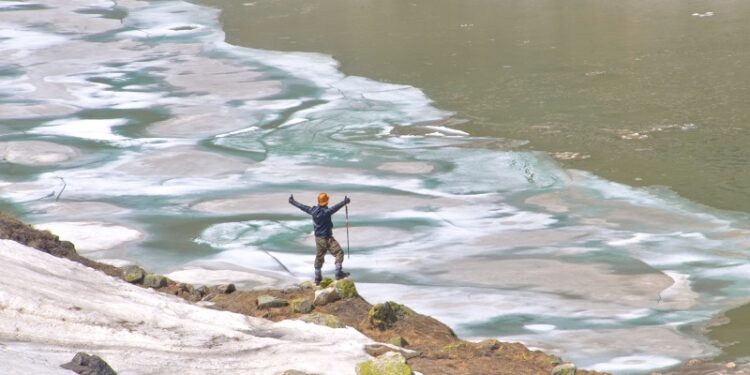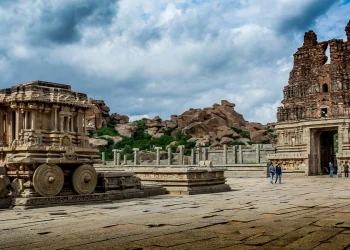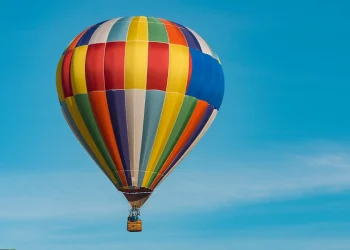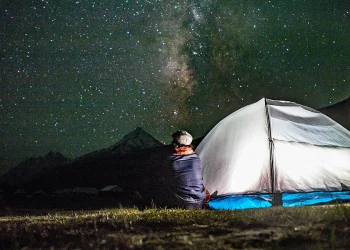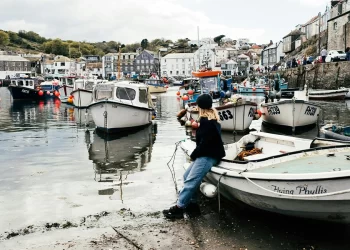By SURAJ DUTTA
Satopanth Tal, a virgin glacier lake at an altitude of 15100 ft (4600 meters above sea level) is a crystal clear green water triangular lake in Chamoli district of Uttarakhand near the Badrinath shrine. The trek presents fascinating views of a number of imposing Himalayan peaks like Chaukhamba, Neelkanth, Swargarohini, Balakun, Kamet and Abi Gamin. This travelogue is a recollection of the author’s trek to the Satopanth Tal in 2016.
After leaving Delhi for Joshimath on May 8th, I returned to Delhi on May 16th after a successful alpine style expedition to the Satopanth Tal becoming the first person of the 2016 season to trek Satopanth.

DAY 1 (May 8): I reach Joshimath by evening and stay at Hotel New Kamal belonging to my friend, Ravinder Shah.
DAY 2 (May 9): Met my guide from Pandukeshwar, a young chap named Somesh Pawar and finalized the trek plan with and secured rations. Visited Auli, only 16 kms away from Joshimath.

DAY 3 (May 10): Finalized permit works and departed for Badrinath by evening. Deepak Rana, my friend from Joshimath had found me accommodation at the Jain Dharamsala (Swetambar) in Badrinath.
DAY 4 (May 11): I along with my friend Ranaji attended the Badrinath Kapat opening event at 4:40 in the morning. As we weren’t granted permit to trek the same day, we trekked to the nearby Vasudhara Falls from the Mana village side. It took us a bit more than 2 hrs to reach the falls which is about 5-6 kms from Mana village and 1.2 hrs to reach back to Mana.
The Satopanth Tal (lake) holds religious significance to the indigenous people residing in the region. The inhabitants of Mana village (which houses the Vyas Gufa, the cave in which Ved Vyasa meditated and composed the Mahabharata) throw the ashes of their dead in the lake.
DAY 5 (May 12): Somesh – my guide comes to fetch me for the trek at 0500 hrs. We embark on the trek by 0600 hrs from Bamni village via Badrinath and Vrigu gufa side (as opposed to the Vasudhara side) crossing the Draupadi temple (place where Draupadi passes away). The first half of the day’s climb was moderate with clear cut path. However, once we cross the Samtoli/ Jhamtoli glacier (source of River Alaknanda), the path disappears into tough a terrain of boulders and numerous small glaciers.

We meet two other guys from Junagadh (Gujarat) and Muzaffarnagar (UP) who impulsively embarked on the trek after coming to know about the Mahabharata legend from locals. They don’t even have a pack of biscuit with them or warm clothes to guard them through the icy night. Obviously by midday, they had to abandon the trek as the trail became increasingly tougher for them; lack of food and the icy air made them all the more fearful. I convey to them how I have been planning since more than a year for this trek and that no one carries such ration-load as we were carrying over such a tough terrain simply for the joy of it.

We cross Laxmivan (place where Sahadev died) which is a beautiful groove of trees beneath us by 1400 hrs and reach Alkapuri by 1600 hrs. My young guide decides to call it a day and camped in front of a cave as the sky was darkening with rain clouds. We had some delicious cave-cooked khichdi in the evening and retire for the night by 8. Somesh was having a splitting headache due to exposure to the winds throughout the day. I shared a dispirin with him and he recovered steadily.
Trek distance for the day: about 12 kms.
As the tale goes, when the Pandavas (from the epic of Mahabharata) and their wife Draupadi embarked on their ascent to heaven after embracing sanyas, they started their journey from Badrinath/ Mana. The trek embarks from Badrinath via Draupadi mandir (where Draupadi dies), Laxmivan (where Sahadev), Sahastradhara (literally means a thousand waterfalls where Nakul passes away), Chakratirth (where Arjun perishes) and then into Satopanth Tal (where Bhim dies) which leads the way to the Swargarohini Glacier, popularly known as the swarg ki seediyan (path to heaven). According to legends, it is believed that this is the only way one can go to heaven without dying which only Yudhisthir was able to accomplish from entire humanity. Thus in a way, this trek captures the ending journey to the eventful live of the Pandavas.

DAY 6 (May 13): We wake up early and start trekking by 0700 hrs. It’s a tough day ahead as we needed to scale/ trek over a near vertical mountain ridge to reach our destination for the day – Chakratirth, the place where Arjun died. It’s a huge circular ground much alike a football arena where Arjun once battled Lord Shiva who was disguised as a tribal. When he couldn’t defeat the tribal after fighting for multiple days, he asked the tribal to reveal who he was on which Shiva revealed his true form and provided Arjun with the Pashupat ashtra (a lethal weapon capable of destroying entire creation). We crossed Sahastradhara (place where Nakul died) in the early noon and reach Chakratirth in the evening around 5pm.
Trek distance for the day: about 8 kms.

DAY 7 (May 14): From our camping ground at Chakratirth, we see the Chakratirth dhar, a flag planted atop a near vertically inclined hill about 1.5 kms ahead of us. We start trekking by 0700 hrs and ascend the hill top in about an hour. We traverse another long glacier after this hill to reach the Satopanth gateway which is marked by two saffron flags. It was 0010 hrs in the morning and about 4.5 kms from the Chakratirth dhar.

After reaching Satopanth, we washed ourselves with the icy water of the tal. Somesh performed a puja followed by a meditation session at the side of the pristine lake. Thereafter, we went to meet the sanyasi maharaj who camped atop Satopanth for the summer months. I had a lengthy philosophic discussion with the sage clearing my mind of many doubts as to the course of my life.

We left Satopanth by 1300 hrs and reach our campsite of the previous night at Chakratirth by 1430 hrs. Packing up everything, we move ahead by 1500 hrs. The path ahead though descending in incline was nonetheless tough because of needing to trek over boulders, thorny bushes and pool of watery fields created by the nearby melting glaciers nearby. This is why an early start on this ultimate day is important since glacial ice starts melting after noon thereby posing risks.

We still manage to reach our Day 1 campsite in Alkapuri area where we set up tent in near darkness and dined inside the cave by 20:00 hrs. This day marked the most extensive trekking of the whole trip. We decided to take it easy while setting destination towards Badrinath and to make a late start in the morning.
Total kms trekked: Charatirth to Satopanth: 6 kms, Satopanth to Alkapuri: 14 kms = 20 kms total.
DAY 8 (May 15): We start trekking back towards Badrinath by 0800 hrs in the morning and got the first distant view of Mana village by 0010 hrs. Crossed the dangerous Samtoli glacier by 1100 hrs, reaching the Draupadi temple by 1200 hrs, we finally arrived at Badrinath by 1300 hrs.
Trek distance for the day: 12 kms.

I met my long time facebook friend Vipul Bhatia at Badrinath who is out there to try his luck with the Mana Pass permit. He recognizes me by my trekking hat and hiking pole. We had a long discussion after which I introduced him to my guide to get all permit related queries clear.

After settling all accounts with my guide and the Jain Dharamsala by 15:00 hrs, I reach Joshimath by 17:00 pm. The plan was to leave immediately for Rishikesh but the evening rain ensured that I avail the hospitality of Ranaji’s home at Joshimath for the night.

DAY 9 (May 16): Leaving Joshimath by 0700 hrs, reached Chamoli by 0900 hrs, Karnprayag in another hour and Srinagar a little after by 1100 hrs. I meet some friends at Srinagar and leave by 1400 hrs to reach Haridwar after 17:00 hrs and Delhi by 22:00 hrs in the night bringing an end to a successful long planned trip. Adios till the next time!

 Suraj ‘Sufi Traveler’ Dutta likes to think of himself as an avid traveller with a sweet tooth for trekking to less explored trails. A lawyer by profession, he was introduced to the unlimited vistas of travelling by means of long distance biking expeditions. Solo biking till date remains his preferred means of travelling and he considers the Enfield Thunderbird as his most prized possession. Trekking to the Everest Base Camp remains at the top of his to-do list.
Suraj ‘Sufi Traveler’ Dutta likes to think of himself as an avid traveller with a sweet tooth for trekking to less explored trails. A lawyer by profession, he was introduced to the unlimited vistas of travelling by means of long distance biking expeditions. Solo biking till date remains his preferred means of travelling and he considers the Enfield Thunderbird as his most prized possession. Trekking to the Everest Base Camp remains at the top of his to-do list.

Founded in 2016, The Traveller Trails is a print and digital magazine and a trusted source for current news, trends, analysis, opinions, interesting blogs, videos and exclusive interviews from every corner of the world.



